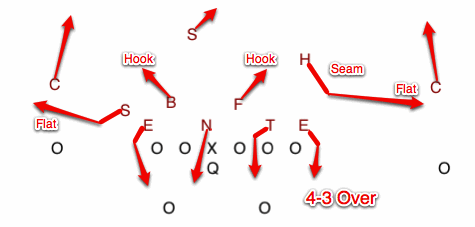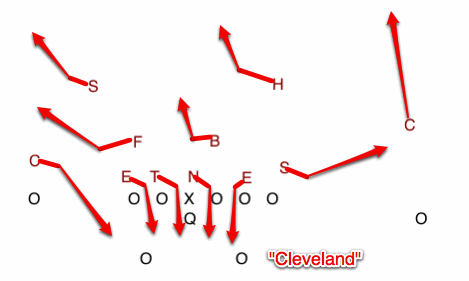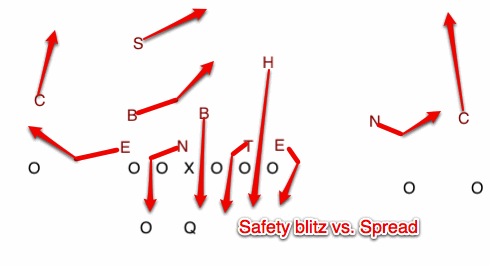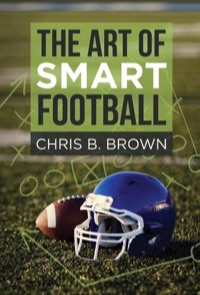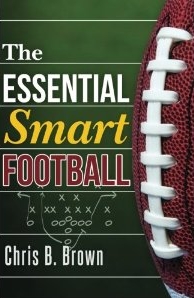Joe Paterno has passed away. I am not the right person to put his lengthy career, decorated career together with the tragedy at Penn State, and, ultimately, his death, in proper context. Others will assuredly do it and do it well. Below is instead a meager contribution to Joe’s legacy, however mixed it may ultimately be. Before the Jerry Sandusky scandal and all that went with it became public last fall, I wrote this simple strategic-focused piece on Penn State’s traditional but very effective approach to defense. I wrote it to be a part of a larger project to be published; once I learned what happened with Jerry Sandusky, Joe Paterno, and so on, the piece simply became an orphan.
So I offer this here not as any commentary on what Joe’s legacy should be; that question now is about a lot more than football. But I hope it is of some value — maybe not today, but at some point in the future — given that it was written in what can only be referred to as a more innocent time, even if that was only just a few months ago.
Penn State’s Defense – Written in August 2011
Penn State will – and should – always be defined by its defense. Despite some glances in the direction of being “Spread HD,” the foundation of the program is its rugged yet simple defensive schemes. When that team, wearing those same, historic uniforms, led by that coach, shuts down a hapless opponent under a sea of blitzes and gang tackles, “Linebacker U” speaks to something primitive within each of us. When you think of Penn State, you think of linebackers with bloody knuckles and neck roll padding, and a camera close-up of the opposing coach and quarterback wearing that “I-just-got-screwed” face after being on the wrong end of a goal line stand – like Michael Douglas at the end of so many of his movies – and all is right with the world.
Joe Paterno must get primary credit for building the program in his tough, irascible image. It’s a legitimate question how involved Joe is on a day-to-day basis these days, but the foundation is his and he still coaches the coaches. And he’s had some great ones, especially on the defensive side of the ball. The defense has evolved in response to the revolutions that offenses have undergone, from option football to I-formation running to west coast passing and even the early rumblings of the spread in the late 1990s. Current de facto defensive coordinator Tom Bradley (in one of its many traditions, Penn State does not actually name its coaches “offensive coordinator” or “defensive coordinator”) and linebackers coach Ron Vanderlinden are among the very best and most knowledgable guys in the game, while anyone who has heard defensive line coach Larry Johnson speak will no doubt remember it for years afterward. Bradley, who nearly left the program to become Pittsburgh’s head coach and was rumored for several other head coaching positions, in particular has kept the Penn State tradition intact, by keeping the framework that Penn State has used for decades while updating it for the newest waves of offensive evolution.
Penn State is nothing if not tradition, and that includes always being surrounded by the ghosts of those who came before you. Each linebacker is given a position name so he can make sense of the defensive calls: “Sam”, “Fritz” and “Backer.” Penn State’s linebackers are supposed to know which historical greats that made “Linebacker U” what it is were Fritzes, which were Sams, and which were Backers. Similarly, in many systems the strong safety is known as a “monster” player because he plays all over the field. For tradition rich, they keep the view Penn State of Rip Engle, who coached the Nittany Lions from 1950 to 1965: that “monster” is a derogatory, déclassé term, and thus the strong safety is known as “Hero.” For Penn State, the age of Eisenhower continues to be the model for present day battles.
And once you go beneath the immediate surface, you see maybe the biggest throwback of all: Penn State, is, quite possibly, the last of the great “Cover 3” teams: the Nittany Lions base their defense on three-deep, four-underneath coverage. What makes this unique is that they eschew the fad or newer coverages like “Tampa Two” or the focus on “Quarters” coverages (though they do have these in the playbook). Of all of the traditions, this focus on Cover 3 seems the most anachronistic, as it is often the first defense installed for many high schools and even at the youth level. But, like the rest of the Nittany Lions football program, it’s old but time tested, and Bradley and company make it work because they get the details right. They tie the front (the defensive line alignment and the position of the linebackers) to the coverages, thus enabling them to get into an old-school, run stopping eight-man front (to overwhelm the offense’s blockers) along with a zone defense behind it
This last point is particularly important. Legendary defensive coordinator Fritz Shurmur, of the Packers and various other NFL stops, explained that the first choice for a defense is whether they are going to base as a man-to-man defense or a zone defense. Man defenses are as you’d think: it’s mano-a-mano, aggressive, and there will never be natural gaps in the defense; but with a zone defense, unlike a man defense, all eleven eyes are always on the ball, and hence your team can run and flow to the ball – as a team. Contrast the team based approach of zones with the more individually focused man defenses and you’ll see other certain problems: the secondary might have their backs turned on option plays and pass plays, and thus increase their chances of giving up big plays if one guy is beat and for foregoing them as there are fewer defenders to play the ball.
For their fronts, the Nittany Lions use both the “under” and “over” fronts. The under front – made famous most recently by Pete Carroll at Southern Cal – is more popular these days, but the “over” front is Penn State’s preferred method of attack. By bringing the strong safety (“Hero” or “H” in the diagram) down as an underneath coverage defender and as a run stopper, PSU is able to get an eight-man front. The coverage scheme in Cover 3 is just as the name implies: three deep defenders, with four underneath ones. Despite being a simple scheme, with adjustments and disguises, it is surprisingly as suffocating as it is sound.
A few notes on this base look. One, the tight-end and most of the offensive linemen are covered up, which gives the linebackers and the Hero plenty of space to roam. And, in terms of personnel, Bradley and company like to put their best interior lineman at the true defensive tackle (“T” or the “3 technique”) spot so that he can play both sides and get maximum disruption. But they also usually will have a true nose guard playing the center, one thing offensive coaches hate. This is because the center has a very difficult job – namely, to simultaneously snap the ball while taking his steps in order to make his block. In addition, being the center, he doesn’t have a specific path in pass protection, so he has to worry about a rusher going to either side of him. I will have more to say about how the Nittany Lions align their nose guard, but the point is that he’s there for a reason. This is the package that PSU goes into every game with, and wants to swarm, stifle, and strangle offenses with simple teamwork and fundamentals.
But this is not to imply that everything Penn State does is elementary, and certainly it is not so obvious – at least it’s not so obvious if you’re an opposing player trying to identify what the Nittany Lion defenders are doing on a given play. Indeed, what makes Penn State’s defense go – what makes the entire old-school-we-still-play-Cover-3 approach sound – is that wired into the old school structure is the latest technology in terms of technique, disguises, and blitz packages. And the fulcrum of Penn State’s defense is the zone blitz.
The beautiful thing about the zone-blitz is it fits PSU’s personality completely: it is both aggressive and conservative all at once. Although it is a blitz designed to get to the quarterback, its number one tenet is not to give up the big play. This is achieved because the scheme is just as the name implies: while it’s a blitz of linebackers and defensive backs, there is a conservative (and generally three-deep) zone behind it. There are essentially two key differences between the zone blitz as practiced by Penn State and its normal base Cover 3: (1) rather than being three-deep and four-under, most zone blitzes are three-deep and three-under defenses and (2) there are five rushers instead of four, and the identities of who is rushing and who is dropping are interchangeable.
The first thing to understand about Penn State’s approach to the zone blitz is the cardinal rule: once a zone blitz has been called, it will be run. The reason for this is JoePa and his staff do not want half of the defense running the zone blitz while the other half is running some other checked defense, all because the offense shifted their tight-end from one side to the other. That is giving the advantage back to the offense. The view is that their blitzes are sound and should work regardless of the front; the only adjustment, if any, is if the offense presents extra receivers, such as an empty or no-back set, an individual linebacker or nickel defensive back can drop into coverage instead of running his blitz path.
Adjustments aside, the goal of a zone blitz is to confuse the quarterback and the pass protectors by being unpredictable regarding who is blitzing, and to be similarly unpredictable as a result for where the voids in the defense are. In ye olden days, if a defense wanted to blitz they rushed six or seven defenders and played man-to-man defense; hence the idea of “hot” reads and a quarterback throwing a quick out or slant pass.
The zone blitz, made famous by Dick LeBeau with the Cincinnati Bengals and later with the Pittsburgh Steelers (along with Dom Capers), completely changed the analysis because the quarterback would see a blitz and an unblocked rusher and think, “No big deal, I’ll throw the slant.” He would then step back, rifle the slant pass and – interception! The indelible image created by those Steelers teams was of a quarterback buried underneath a couple of linebackers and a defensive back who had blitzed while a husky defensive end rumbled down the sideline having intercepted the hot route. That, for sure, is a zone blitz, but remember that the zone blitz is anytime the defense combined a true blitz and a true zone; sometimes a defensive lineman dropped into coverage but that was not necessary or even always desirable for confusing the quarterback. For him, it is enough that he has instant pressure and did not expect a zone at all, and thus even linebackers and defensive backs, to say nothing of defensive lineman, can act unpredictably.
And yet, let’s say the offense managed to pick up the blitzers and give the quarterback time. Against an all-out man-to-man blitz, this was bad news for the defense, as a good quarterback would stand back there and try to hit a receiver running free on a deep post or corner route without safety help. This is not a concern with the zone blitz, as Penn State is able to stay in its trusty old three-deep and keep the receivers in front of them. Obviously there are examples where a guy gave up a big play or things broke down, but the structure is sound.
Turning to a specific example, the first blitz JoePa’s staff puts in is called “Seattle” (don’t ask why). This zone blitz comes out of the 4-3 “Over” look that PSU likes to spend most of its time in, and, in it, the defensive line shifts and stunts to the tight-end side, up through the defensive end to that side who actually drops into pass coverage, looking first for a quick slant and eventually covering the flat. The “Fritz” backer drops to cover the middle “hole” area, while the safety to the weak side covers the curl or alley area to the flat. The two corners and the other safety take the deep thirds of the field, respectively. That’s the zone part. The blitz is from the other two linebackers (“S” and “B”) who scrape to the outside of the defensive end who pinches inside (hopefully getting the offensive tackle to turn his hips) as they overload the weakside. The goal here is to both have a sound zone coverage while overloading the pass protection scheme and getting a free rusher. This is the holy grail of pass defense: to have good coverage, an unblocked blitzer, and offensive linemen blocking no one, as they would to the frontside.
Now, if the offense can protect against the onrushing blitzers there are open voids to be had, but that is a big “if.” Moreover, the point of dropping the defensive end is unquestionably not to have him fly into that area and make all kinds of plays – not since Courtney Brown and LaVar Arrington has PSU had outside rushers who could play that way in space consistently. Instead the idea is more along the lines of the element of surprise: if the quarterback did throw that way, he would not expect the defensive lineman to be there, but, more importantly because he does drop back, the defense can cover the area the quarterback would most expect to be open – where the blitzers came from. That kind of confusion and the resulting hesitation is what causes interceptions and sacks.
The second blitz that PSU installs is called “Cleveland” (again don’t ask). This one is from the 4-3 Under front – this puts the strongside linebacker to the tight-end side and shifts the line to the weak side of the formation. Cleveland has the same principles as above: the line slants (though the strongside defensive end pinches inside the opposite direction from where the rest of the guys are slanting), and the coverage is a basic 3-3 – three-deep and three-under coverage. But here instead of three defensive linemen and two linebackers blitzing, it is four defensive linemen and a cornerback. The Nittany Lions always call this from the boundary – i.e. the nearest sideline if the ball is on the hashmark – so that the blitzing corner has a shorter path to get the quarterback and can disguise it better. But what if the cornerback is not a good blitzer? They can make a simple call – such as “Browns” – to run the same blitz but have the safety bring the heat while the corner drops. And so on: these variations are endless – sound in scheme, violent in principle, and easy to teach.
The last specific blitz I’ll show is one designed to combat the shotgun spread looks that have become more and more prevalent. The offense below is in a “trey” set, with two receivers and a tight-end to the right and a single receiver backside. In response Penn State has brought in a nickel pass defender, who aligns over the slot to take away the quick pass or bubble screen. The defensive front is in an “Over” look, but has adjusted to the one-back set it faces. As shown below, the defensive end to the boundary side drops off, which is advantageous in that he has less room to work and can even step in the passing lane if the offense tries to throw a quick slant to the single receiver. But the frontside is where the action is.
The defensive tackle and end slant in opposite directions, opening the crease for the blitzing safety. In addition, the center is in a massive bind for pass protection, as while he has a nose guard to worry about he has a blitzing linebacker right next to him, and the offensive guard to his right is dealing with the same linebacker and the defensive tackle, and so on. It’s certainly possible to draw up ways to block this blitz – the offense does have the numbers to do so – but it’s not easy, certainly not in a game situation.
Indeed, Bradley, Vanderlinden and the rest of the defensive staff work hard to teach the defenders to “bluff” a lot of blitzes – Penn State wants to blitz less than half the time, so when they do they want it to be very effective. They’ve had good success giving guys the freedom to fake and move, leading to the sense of “controlled chaos” – and impending doom – from the offense.
But with this controlled chaos is strategy: note that the blitz above is all done away from the pass protection helper, the runningback. Bradley in the past has described that he often gives players specific assignments depending on the alignment of the runningback, particularly in a shotgun offense. For example, the noseguard may be taught to slide to one side of the center or to attack a specific gap depending on the runningback’s alignment. This is because the his alignment to the right or left of the quarterback can be a giveaway, as typically a runner will pass protect to the side he’s aligned to but run to the opposite side, though good teams break tendencies. (This is also why the “pistol” set with the runner behind the quarterback is useful as it helps eliminate defensive keys, though it is overdone to tout the idea of moving the runningback a couple of feet as suddenly creating some kind of magical new offense.)
A few other teaching points that make the zone blitzes go for Penn State. One very important one is the concept of the “flow blitz.” What this means is that if you are a linebacker assigned to blitz between the tackle and tight-end, but it becomes immediately apparent that the ball is going the other way, then instead of blitzing the linebacker should move in the direction the ball goes. If there is a cutback that linebacker can still knife through for a tackle in the backfield, but he should not zoom upfield and into the backfield on a blitz while the play is entirely to the other side.
Penn State’s defense is throwback chic; more traditional, more disciplined, more focused, and more brutal than most of its modern counterparts. Paterno’s defense has ridden through revolutions and ended up ahead of the curve. Indeed, if you look around college football and ask who does it like Penn State – lots of single-safety, Cover 3, and zone blitzes – the best analogue is probably Nick Saban, a guy who knows a thing or two about defense. But in State College they have their own way. And maybe that’s the thing that’s best about a good Penn State defense. It’s as sound as it is simple, and both of those things let the players make plays.





